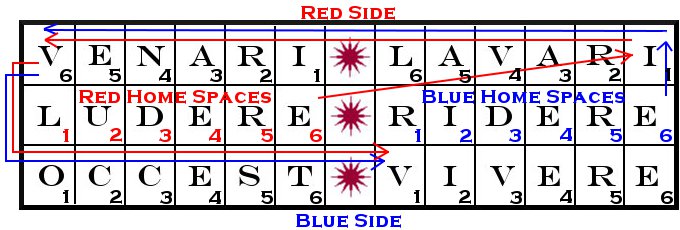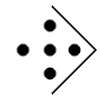The Latin name of the game, Ludus Duodecim Scriptorum, means "game of the twelve lines." It was a popular game in the Roman Empire. A picture of people playing this game was found on the back of a Roman hand mirror (c. 2nd or 3rd century BC), although the version that you will find here may actually be a later form of the game that evolved from a more complex game from Egypt (Bell, Board and Table Games 30). Duodecim Scriptorum (as the game is also called) lost its popularity in the 1st century AD as more people began playing Tabula (Bell, Board and Table Games 33). Duodecim Scriptorum may also have been played in Ancient Greece under the name Grammai (Parlett, The Oxford History 70). There is no surviving ancient description of the rules, but scholars have re-created a set of rules reasonably close to the original using game boards that have been found and the rules for the related game Tabula (Bell, The Boardgame Book 84).
Duodecim Scriptorum
The rules for this game come from The Boardgame Book by R.C. Bell, pp. 84-85, with additional information from The Oxford History of Board Games by David Parlett, pp. 70-72, and The Book of Games by Jack Botermans, pp. 289-298. Although I really consider Bell to be the more reliable source, I found his list of instructions vague on a number of points. I used Botermans to clarify a number of these, although I don't think that Botermans's book is as well-researched and documented. (See Bibliography for more information). If you've already read the rules for Tabula, you'll see that they have many features in common.
Players: 2
Object: To be the first to remove all of your pieces from the board.
Equipment: Aside from the game board (printable), you will need three six-sided dice and two sets of fifteen discs in two different colors to use as playing pieces (You can cut the pieces from construction paper. In the examples, I use red and blue for the different sides because the colors show up well, but you can use other colors. You can use other things as playing pieces, but whatever you use should be flat and stackable.)
The Board: The designs of the game boards could vary, but generally they contain three rows of twelve spaces, six on each side of the board, with a space or symbol separating each half. The six spaces on each side could be marked with lines, symbols, or letters of the alphabet. Sometimes, these letters would spell out six-letter words. For instance, one board contained the words "Venari Lavari Ludere Ridere Occest Vivere" which means "To hunt, to bathe, to play, to laugh -- this means to live!" (Parlett, The Oxford History 71).
Although the board can say anything you like or just be decorated with random letters or symbols (the decorations or words are really just for fun and not important to the game play -- you could just as easily have a board that says "Muffin, Cookie, Turtle Sundae, Sweets, Nummy!" with the exclamation point getting its own space), I decided to use the saying above for my example board. You could number the spaces (I have an example below with spaces numbered to show movement), but adding words or symbols makes the board a little more colorful. (Note: Roman boards wouldn't have the lines to make boxes around the letters or symbols like my board does. I added them just to make the board easier to understand, so players would have clearly defined spaces.)

Beginning: At the beginning of the game, the board is empty, and each player receives a set of fifteen discs. One player sits at the top of the board (which is the side that says "Venari Lavari" on this board), and the other sits at the bottom (the side saying "Occest Vivere"). The two players decide which of them will go first (Botermans 290).
There are three phases to the game. During the first phase, the players put their pieces on the board. In the second phase, the players move the pieces across the board. In the third phase, the players take their pieces off the board (Botermans 290).
Placing Pieces: The six home spaces for each player are on the middle row of the board. Each player's home spaces are on their right-hand side (Botermans 290-291). (In this example, the red player's home spaces are on the word "Ludere", and the blue player's home spaces are on the word "Ridere.") The players take turns rolling all three dice and placing their pieces on their home spaces.
The numbers on the dice (or the total of these numbers) indicate where to put the pieces within the home spaces. The numbers on the three dice can be totaled or used separately. If used separately, a player can place three pieces on the board instead of just one. In fact, it is possible to total two of the dice and use just one separately (Botermans 291, 296). There will be multiple pieces on one space at the same time, and there is no limit to the number of pieces which can share the same space. The players cannot begin moving their pieces from their home spaces until all of their pieces are on the board.
Tips for Placing Pieces: I've numbered the spaces on the board below to help demonstrate where the pieces should go. For example, if a player rolls 1, 2, and 3 on the three dice, there are several different ways he can place his pieces on the board, depending on how he wants to total the numbers on the dice or if he wants to use each one separately. The player's options are:
- Place one piece on the 1 space, another piece on the 2 space, and the third piece on the 3 space.
- Place two pieces on the 3 space (1 + 2 and the 3 used separately).
- Place one piece on the 5 space (2 + 3) and one piece on the 1 space.
- Place one piece on the 4 space (1 + 3) and one piece on the 2 space.
- Place just one piece on the 6 space (1 + 2 + 3).
The advantage of putting a piece on the 6 space is that a piece on the 6 space would move more directly onto the next set of six spaces when it's time to start moving pieces. Of course, the more the player uses the dice numbers separately, the more pieces he can put on the board at a time and the faster he can move on to the next phase of the game. How the player totals his dice is up to him.
Since this phase of the game is all about placing pieces and all of the pieces have to be placed on a player's home spaces, if the total of the dice is more than 6, the numbers on the dice have to be used separately instead of together. For instance, if the numbers on the dice are 2, 4, and 6, the total of the numbers will be 12. Since there is no 12 space on a player's home spaces, the player cannot use the total of all three dice to place a single piece. The player can use the numbers on the three dice separately to put three pieces on the board on spaces 2, 4, and 6 of his home spaces. Alternatively, he can total the 2 and the 4 to make 6, and put two pieces on the 6 space.

Moving Pieces: When a player has all fifteen of his pieces on his home spaces, he can start moving them around the board in the direction shown by the arrows. The players never have their pieces on each other's home spaces. Note that the red player's pieces jump directly from the last of the red player's home spaces to the first space in the next row. Each player's pieces have to follow the path around the board and leave the board through the very last set of six spaces (marked by the word "Vivere" in this case).
The players continue to roll all three dice to determine how many spaces to move. As the players move, friendly pieces can continue to share spaces with no limit. What happens when unfriendly pieces meet is described under Capturing and Blocked Pieces.
Determining Possible Moves: Just like in placing the playing pieces at the beginning, the numbers on the individual dice can be totaled so that players can move fewer pieces longer distances or used separately to move up to three pieces shorter distances. However, players are no longer limited to keeping the pieces within a set of six spaces. Once a piece reaches the end of a set of six spaces, it immediately goes on to the next set of six and, eventually, off the edge of the board after passing through the last six spaces (marked by "Vivere").
Example: Suppose that a player rolled 1, 2, and 5 on the three dice. The player's possible moves are:
- Move one piece 1 space, one piece 2 spaces, and one piece 5 spaces.
- Move one piece 3 spaces (1 + 2) and one piece 5 spaces.
- Move one piece 6 spaces (1 + 5) and one piece 2 spaces.
- Move one piece 7 spaces (2 + 5) and one piece 1 space.
- Move one piece 8 spaces (1 + 2 + 5).
Players do not roll again if they get doubles or triples on a roll.
The one thing a player cannot do is ignore one of the dice. All of the numbers on all three dice have to be used in one of the ways described above. If a player cannot use all three numbers, he must forfeit his turn (see Blocked Pieces) (Botermans 291).
Capturing: The two players' pieces can never safely land on the same space. Playing pieces are safe on their own home spaces, but on any other space, they are vulnerable to capture. A player can capture another player's piece only if it is alone on its space. Lone pieces are called wanderers ("vagi"). The opposing player can capture a wanderer by landing on the same space with one of his pieces. Once a piece is captured, it is taken from the board and has to be placed back in its owner's home spaces on the owner's next turn (use the rules for placing pieces at the beginning of the game).
The best way to prevent the other player from capturing your pieces is to make sure than no piece is alone on its space. When a player has multiple pieces on the same space, those pieces are called orderlies ("ordinarii"). Orderlies are safe from capture as long as they stay together on the same space because they protect each other, and the opposing player cannot land on a space with orderlies.
However, a player's piece can move through spaces occupied by their opponent's orderlies as long as there is a space beyond them where the player's piece can land (Botermans 296-297).
Blocked Pieces: Sometimes, a piece can be blocked so that it is impossible to move so matter what numbers the player gets on the dice. This happens when the opponent has a series of orderlies in front of the other player. Pieces in that position are called immovables ("inicti").
If a player has other pieces to move, he can continue to play. If the immovables are the player's only pieces, the player must forfeit his turn until his pieces can be moved (Botermans 294).
Winning: The first player to take all of his pieces off the board by passing through all of the other spaces on the path wins.

